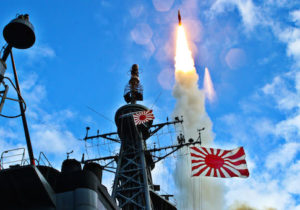by WorldTribune Staff, October 4, 2016
North Korea’s ballistic missile technology is progressing at a pace that could pose a major problem for Japan’s missile defense capabilities, Japanese military sources say.
The Kim Jong-Un regime in Pyongyang has test fired 21 ballistic missiles since the start of the year, leaving Tokyo unsure it could fend off a missile strike without U.S. help, the sources told Reuters.

“North Korean ballistic missile technology is progressing step by step and every time we raise our capability they improve theirs,” a Japanese Self Defense Forces (SDF) source said.
Japan plans to upgrade its ballistic missile defenses, but those upgrades are not due to begin until April 2017 at the earliest. Deployment of new systems designed to destroy incoming warheads could take years to complete, the sources said.
“There is a limit to what our current ballistic missile defense system can achieve,” one SDF source said, asking not to be identified because he isn’t authorized to speak to the media.
For now, Japan has four Aegis destroyers each equipped with eight SM-3 missiles. Two of those, however, are laid up for maintenance leaving only two available to watch for North Korean missiles, a source told Reuters.
The heightened threat “comes just as we face a pinch with our Aegis fleet,” the source said. “Cooperation with the U.S. Aegis ships deployed in Japan is going to be crucial.”
Tokyo and Pyongyang have been locked in an arms race since 1998 when North Korea fired a missile over Japan.
In June, North Korea successfully tested a medium range Musudan rocket that reached an altitude of 1,000 kilometers (620 miles) on a lofted trajectory, a breakthrough that could allow Pyongyang to fire warheads over the range of Japanese BMD Aegis destroyers patrolling the Sea of Japan.
Such a scenario would leave older PAC-3 Patriot missile batteries protecting major cities including Tokyo as a last line of defense. A $1 billion program to improve their range and accuracy will begin after March, but the first will not be ready until the 2020 Tokyo Olympics, sources previously told Reuters.
The Musudan, which can fly as far as 3,000 kilometers (1,860 miles), also plunges from space at speeds reaching 21 kilometers (13 miles) per second, potentially too fast for existing Patriot batteries.
Japan’s Ministry of Defense also plans to improve the performance of SM-3 missiles on its small Aegis fleet. The SM-3 missiles are designed to hit warheads at the edge of space, but the sources who spoke to Reuters were unsure they could take on the Musudan.
A more powerful version of the SM-3 jointly developed by Japan and the United States, dubbed the Block IIA, is nearing completion, with Japan planning to buy the first of those next year. It has not, however, said how many it will acquire, or when they will be deployed.
In the longer term, Japan is considering buying Lockheed Martin’s Terminal High Altitude Air Defence (THAAD) system, to add a middle layer to BMD, or build Aegis batteries on shore to bolster its defenses.
The U.S. is stepping up help to neighboring South Korea, promising last week to speed up deployment of THAAD batteries there.
“We still think they need time, but whatever the purpose is, the North is doing things at a rate that is beyond our imagination,” South Korean Defense Minister Han Min-koo said in parliament in late August.
Pentagon spokesman Commander Gary Ross said the United States had recently reaffirmed its “unwavering and ironclad” commitment to defend both South Korea and Japan, “guaranteed by the full spectrum of U.S. military capabilities, including conventional, nuclear, and missile defense capabilities.”
